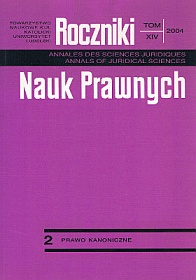The Essence of litis contestatio in the Canon Trial
Abstract
The complaint submitted by the plaintiff initially defines the object of the litigation. This is done by the plaintiff himself with his own authority and responsibility. It is required by justice that the defendant be allowed to speak. He may accept the complaint as right or reject it. The means to sort it out is to determine the object of the litigation. This is done when the complaint is established by both parties before a tribunal and with a judge's formal support.
An essential and necessary stage of the lawsuit is to define the formulation of the litigation. It is said to be the first strictly suit stage. In view of the fact that the essence of the formulation of the litigation is a precise question which determines the course of argumentation, an answer to this question decides about the sentence. Therefore it seems very important that the judge should apply any available possibilities to settle the range of the litigation with the parties' full approval. In order for the participants of the suit, the parties and the judge, to fully use their entitlement in this issue, it is only right to fully present the code norms that directly or indirectly refer to the legal reality of litis contestatio. This allows us to understand in an unambiguous way particular aspects of the institution litis contestatio itself. We can also distinguish the Latin term from its other Latin counterparts, i.e. its related concepts, or even colloquially identical, such as controversia and dubium, which in reality denote a different lawsuit reality.
Copyright (c) 2004 Roczniki Nauk Prawnych

This work is licensed under a Creative Commons Attribution-NonCommercial-NoDerivatives 4.0 International License.


